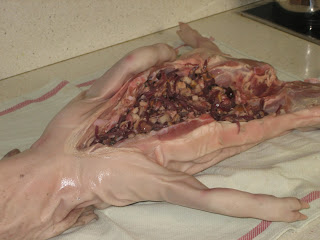Offal is a word capable of scaring even the manliest of men and many people are put off by only the thought of it. For most the mention of eating brains probably congers up memories of the monkey brain eating scene in Indiana Jones and the Temple of Doom but you really needn’t be scared.
As a chef I decided lambs brains were probably something I should try. I consider myself to be fairly open minded when it comes to food and as brains are available in every supermarket here in Spain I thought I should give them a go.
The idea that brains might actually taste good and not just be something to tick off a list first came to my attention via Hugh Fearnley Whittingstall.
After reading an article about them I decided to get some in and give them a try.
My first attempt failed miserably. I bought the brains a couple of days before my dad was coming out to visit so I could cook them up for us both to try. I was well up for tasting the wobbly looking fellas but I certainly wasn’t going to do it alone. Sadly when I came to open them up they were bad and had to be thrown in the bin, the idea was sidelined.
My second attempt was much more successful. This time it was while a really good friend was visiting, a friend who really knows how to eat and I knew he would appreciate the experience as much as me.
As we started preparing the brains we were like kids, taking silly photos and larking about but then we got down to the serious cooking.
I can’t take any credit for the recipe as with no experience I turned once again to Hugh for advice.
A really easy thing to cook, we poached them gently in water for about 20 minutes with a bay leaf, a chili and a spoon of vinegar, drained and cooled we dredged them in seasoned flour and pan fried them in half olive oil, half butter until they started to crisp up. At the last minute we threw in a hand full of capers and sage leaves.
Once we put it on the plate and served it up with slices of toasted baguette it actually looked rather appetizing.
Cutting into the brains for the first time, through the crispy outside into the smooth creamy middle I was a little bit nervous. As I spread it on a piece of toast I wasn’t quite sure what to expect. We both ate it at the same time.
As I started to chew I really was pleasantly surprised at just how good lamb’s brains are. If you imagine a creamy texture and delicate flavour like a cross between pate and foie gras, In fact if you like pate and foie gras I can guarantee you will love lamb’s brains. The capers and sage leaves from this recipe add a nice depth to the dish without detracting from the true flavour of the brains.
Whenever you thought of offal I’m sure that until now all that came to mind was liver and kidneys. From now on I implore you to delve a little deeper into the world of “nasty bits”. Don’t be scared to try new things, you might just be surprised.















